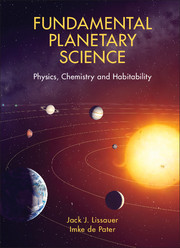Description
Fundamental Planetary Science
Physics, Chemistry and Habitability
Authors: Lissauer Jack J., de Pater Imke
Language: English
Subject for Fundamental Planetary Science:
Approximative price 57.55 €
In Print (Delivery period: 14 days).
Add to cart
Publication date: 09-2013
616 p. · 18.7x24.7 cm · Paperback
616 p. · 18.7x24.7 cm · Paperback
Description
/li>Contents
/li>Biography
/li>
A quantitative introduction to the Solar System and planetary systems science for advanced undergraduate students, this engaging new textbook explains the wide variety of physical, chemical and geological processes that govern the motions and properties of planets. The authors provide an overview of our current knowledge and discuss some of the unanswered questions at the forefront of research in planetary science and astrobiology today. They combine knowledge of the Solar System and the properties of extrasolar planets with astrophysical observations of ongoing star and planet formation, offering a comprehensive model for understanding the origin of planetary systems. The book concludes with an introduction to the fundamental properties of living organisms and the relationship that life has to its host planet. With more than 200 exercises to help students learn how to apply the concepts covered, this textbook is ideal for a one-semester or two-quarter course for undergraduate students.
1. Introduction; 2. Dynamics; 3. Solar heating and energy transport; 4. Planetary atmospheres; 5. Planetary surfaces; 6. Planetary interiors; 7. Magnetic fields and plasmas; 8. Meteorites; 9. Minor planets; 10. Comets; 11. Planetary rings; 12. Extrasolar planets; 13. Planet formation; 14. Planets and life; Index.
Jack J. Lissauer is a Space Scientist at NASA's Ames Research Center in Moffett Field, California, and a consulting professor at Stanford University. His primary research interests are the formation of planetary systems, detection of extrasolar planets, planetary dynamics and chaos, planetary ring systems and circumstellar/protoplanetary disks. He is lead discoverer of the six-planet Kepler-11 system, co-discoverer of the first four planets found to orbit about faint M dwarf stars, and co-discoverer of two broad tenuous dust rings and two small inner moons orbiting the planet Uranus.
Imke de Pater is a Professor in the Astronomy Department and the Department of Earth and Planetary Science at the University of California, Berkeley, and is affiliated with the Delft Institute of Earth Observation and Space Systems at Delft University of Technology, The Netherlands. She began her career observing and modeling Jupiter's synchrotron radiation, followed by detailed investigations of the planet's thermal radio emission. In 1994 she led a worldwide campaign to observe the impact of comet D/Shoemaker–Levy 9 with Jupiter. Currently, she is exploiting adaptive optics techniques in the infrared range to obtain high angular resolution data of bodies in our Solar System.
Imke de Pater is a Professor in the Astronomy Department and the Department of Earth and Planetary Science at the University of California, Berkeley, and is affiliated with the Delft Institute of Earth Observation and Space Systems at Delft University of Technology, The Netherlands. She began her career observing and modeling Jupiter's synchrotron radiation, followed by detailed investigations of the planet's thermal radio emission. In 1994 she led a worldwide campaign to observe the impact of comet D/Shoemaker–Levy 9 with Jupiter. Currently, she is exploiting adaptive optics techniques in the infrared range to obtain high angular resolution data of bodies in our Solar System.
© 2024 LAVOISIER S.A.S.




